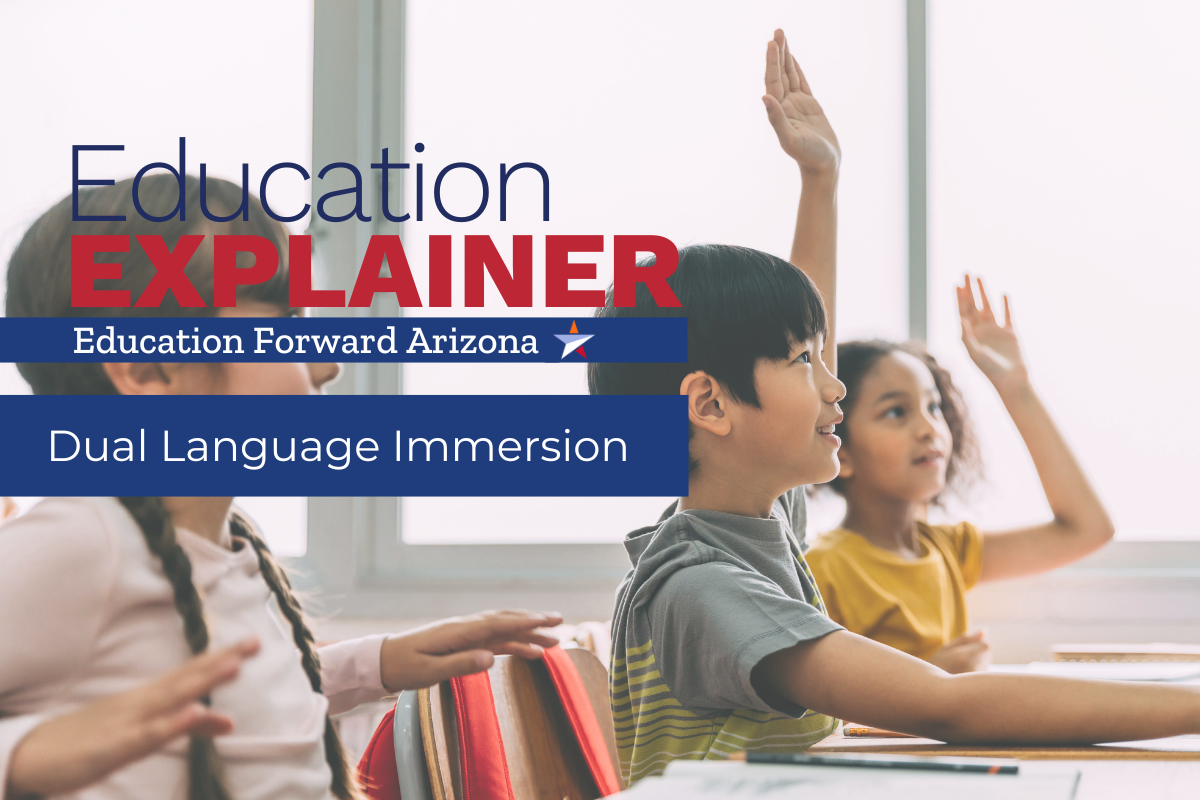
Education Explainer: Dual Language Immersion
What is Dual Language Immersion?
Students in a Dual Language Immersion program learn academic content where at least 50% of the instruction is in English and 50% is in a partner language, i.e. Spanish, Mandarin Chinese, Navajo. Students learn to listen, read, write, and speak in two languages while also developing cultural awareness and appreciation. Dual Language Immersion programs are not just for English Language Learners and the result has been to develop students that are bilingual, biliterate, and bicultural. School districts that offer Dual Language Immersion programs state that the benefits include preparing students for college and career in a competitive global environment, developing positive cross-cultural attitudes and behaviors, and are taught a high-quality curriculum in all academic disciplines to enhance biliteracy, bilingualism, and academic success. Other benefits have shown that students perform as well as or better than non-DLI students on standardized tests of English and Math and Native Spanish speakers make better progress in acquiring full proficiency in English.
History of Dual Language Immersion Programs:
Dual Language Immersion programs are not a new concept and have been used in the United States for several decades. Across the United States, it is believed that there are approximately five million students who are English Language Learners. As a result, more and more school districts are developing Dual Language Immersion programs to not only meet the needs of these students, but at the request of parents who recognize the value of knowing a second language. The goal of a DLI program is to provide students with academically rigorous content that will develop bilingualism and biliteracy and prepare students for academic and career success in an increasingly competitive global environment.
In Arizona, DLI has been offered by certain school districts since the 1990s. Examples of well-structured research-based DLI programs include: Chandler Unified School District for both Spanish and Mandarin Chinese, Osborn School District offers a Spanish DLI program, and Flagstaff Unified School District offers two programs in Spanish and Diné (Navajo).
While Dual Language Immersion programs are not new to Arizona, what has changed is the ability for English Language Learners to participate in a DLI program. Until 2020, Structured English Immersion (SEI) was the standard way for non-English speaking children to learn English in Arizona; these students are known as English language Learners (ELL). In a SEI class, students are taught in an English-only environment and the results have not always been favorable for academic learning. In 2020, the State Board of Education officially approved dual language programs as an acceptable model for English Language Learners.
What does the research say?
Osborn School District states that in 2022, Sixth and Eighth Grade students in their program scored higher than the national average in the Spanish AAPPL (ACTFL Assessment of Performance toward Proficiency in Languages).
The state of Utah has established Dual Language Immersion programs and has been able to document their success. They have found that English Language Learners enrolled in DLI programs out-perform non-DLI students.
“On math and language arts proficiency tests in 2012, about 20 percent more English language learners who’d been enrolled in two-way immersion for three years at Heber Valley achieved proficient scores when compared with English language learners statewide not enrolled in two-way immersion. English-speaking students in two-way immersion programs tended to do better as a group on average than their counterparts in the school district and in the state overall.”
Portland Public Schools (PPS) in the state of Oregon has been offering dual programs since the mid-1980s and have reliable data showing that DLI students outperformed non-DLI students on a statewide accountability test in Reading. DLI students also scored as well as non-DLI students in math and science instruction. The biggest impact has been for English Language Learners who enrolled in a DLI program in kindergarten; these students reached English proficiency at a much higher rate by Sixth Grade.
Across the United States
The US Secretary of Education Miguel Cardona has developed the “Raise the Bar: Lead the World” initiative. It is a call to action to transform education and unite around decades of research to advance educational equity and excellence. One of the key focus areas is to “Create Pathways for Global Engagement” by providing opportunities for our students to become multilingual. This is a recognition of the diversity of the United States and that English Language Learners are one of the fastest-growing student populations in our K-12 schools, recognizing that opportunities for ELL students are often limited. Ultimately, the goal is that all students will have the opportunity to become multilingual and Dual Language Immersion programs have a proven track-record of leading to multilingual students.
References:
“Utah’s Bilingual Boon” AZ DLI Network – DLI Research (google.com)
https://sites.google.com/view/azdlinetwork/dli-research?authuser=0
https://www.rand.org/pubs/research_briefs/RB9903.html
https://www.osbornnet.org/Page/203
